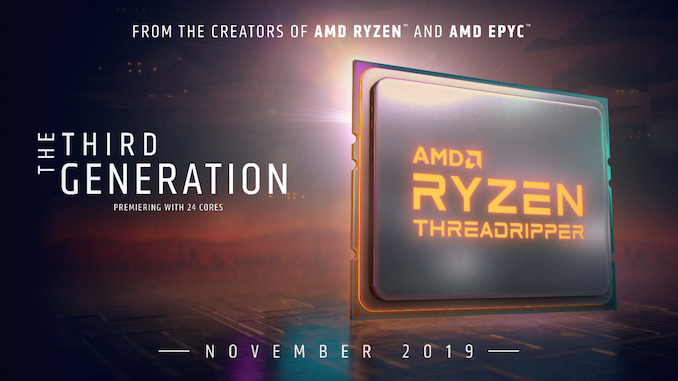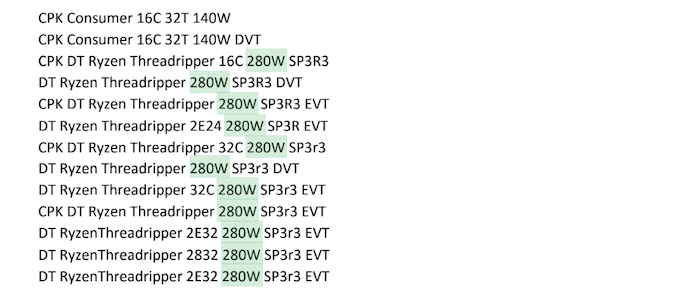Details About 3rd Generation Ryzen Threadripper Appear: 24 and 32 Cores, Up to 280 W
by Anton Shilov on October 21, 2019 12:00 PM EST- Posted in
- CPUs
- AMD
- ThreadRipper
- Zen 2

AMD has already officially confirmed plans to launch its 3rd Generation Ryzen Threadripper processors this November, but naturally kept all the details to itself. At the time, it stated that the first products to market will be 24-core products. According to the company’s Product Master document that was published by AMD, it looks like some preliminary information about the CPUs is now in.
Based on the document (as well as previously released claims by the company), AMD’s Ryzen Threadripper 3000-series family will include 16-core, 24-core, and 32-core CPUs with a TDP up to 280 W for its most extreme parts. This is up from a 250 W TDP featured by AMD’s Ryzen Threadripper 2000 processors with up to 32 cores. The new process technology along with a higher thermal design power will likely enable the new CPUs to run faster and offer a significant performance increase when compared to predecessors (plus, keep in mind performance boost from the Zen 2 microarchitecture).

From AMD's Master Product Document
The new CPUs are also said to use a new variant of the SP3 socket called SP3r3, which questions if they will be drop-in compatible with previous-gen motherboards. Considering the fact that AMD is preparing new chipsets for its next-generation Ryzen Threadripper processors, but has been stated with providing socket compatibility, it will be interesting when AMD defines the compatibility table. This is likely a differentiator for PCIe 4.0 support.
AMD’s Product Master list is seemingly targeted at the company’s sales teams and contains OPN codes along with US ECCN, HTS, and CCATS codes that are required by the US export regulators. Although the document mentions a variety of products, at least some of them are potential or partner-specific devices not exactly located in the company’s roadmap for mass products. Therefore, the information from the list should be taken with a grain of salt, as some of these parts may not be hitting the market.
Related Reading
- AMD: Next Gen Threadripper and Ryzen 9 3950X, Coming November
- TRX40 Chipset For Upcoming AMD Ryzen Threadripper Listed
- AMD Brings Ryzen 9 3900 and Ryzen 5 3500X To Life
- AMD Ryzen 9 3900: A 12-Core 65W CPU Listed
- AMD Ryzen 5 3500 & 3500X Support Spotted
- AMD Announces Ryzen Pro 3000 Series CPUs For Q4
Sources: AMD, Reddit, Tom’s Hardware, Komachi_Ensaka/Twitter, Planet3DNow.de










19 Comments
View All Comments
MenhirMike - Monday, October 21, 2019 - link
I think I'm a minority, but I would love to have a 65W or at least 95W Threadripper, mainly for the PCIe lanes. I'm running a TR1900X which has enough Oomph on the CPU-side, primarily because I needed about 32 or 36 PCIe lanes. I know that lanes (and memory channels) are the expensive parts in terms of TDP, and I know that the Snowy Owl EPYC 3xxx exist, but those aren't consumer parts, or at least I can't seem to find a EPYC 3251 CPU on its own.hnlog - Monday, October 21, 2019 - link
+1 I'm also need low-power and many-PCIe platform.Valantar - Monday, October 21, 2019 - link
Considering that the Infinity Fabric and other uncore parts on the 1920X in my partner's workstation easily pull 70W by themselves I don't think that is possible withouteither shedding lanes or downclocking the IF link - which would make this kind of pointless. Of course the situation with Zen2 and an I/O die would be different, but 65W is likely not possible no matter what. As for 95W, I don't think there is enough of a market to sell 95W HEDT CPUs just for the I/O in consumer channels. The vast majority of consumers - even those who can make use of workstation-grade hardware - have more need for a fast CPU than massive I/O.Arnulf - Monday, October 21, 2019 - link
You don't have to run your TR at stock multiplier - it runs perfectly fine with lower multiplier setting, significantly reducing power consumption ("TDP"). There is a reason plenty of server-grade stuff runs in high 1.x-2.x GHz range.GreenReaper - Monday, October 21, 2019 - link
But... doesn't PCIe lanes being expensive in terms of TDP rule out a low-power Threadripper?The linked document places the difference with the 'consumer' 32C product at 140W vs. 280W. Even if you take out everything on that side - including all the cores - you're left with 140W. You could probably downclock it, but are you truly better with two slower lanes than one faster one?
MenhirMike - Monday, October 21, 2019 - link
Yeah, though the EPYC 3251 offers 32 PCIe 3 lanes, dual channel memory, and 8x 2.5 GHz cores at 50W TDP - so compromises are doable. The EPYC 3301 does 64 PCie 3 Lanes, 12 Cores at 2 GHz, and Quad Channel memory at 65 W TDP. Both also have 4x 10 GBit Ethernet.Seriously, the EPYC 3xxx CPUs are perfect, but they aren't sold as single CPUs, but meant to be soldered on a mainboard, and the mainboards with this are lacking in features. But once I'm due to upgrade my existing TR, I'll definitely keep an eye out for an EPYC Embedded system instead.
Noodle-Naut - Monday, October 21, 2019 - link
When AMD gives a Wattage that is at maximum. If you are not pushing the CPU, your power use will be much less. Intel presents their Wattage differently.The big boards and lots of memory will eat some Watts too, though.
Dug - Monday, October 21, 2019 - link
I think the same thing. I want pcie lanes too.I don't want my storage/ network/ tb3/ or any other connection to be limited.
Personally I think there is a large market for lower power, small, workstation/ server systems, but they don't realize it. Especially if they can get hardware compatibility list with Windows and Linux.
techguymaxc - Monday, October 21, 2019 - link
Hopefuly these are just 3960x and 3970x. If either of these chips is above that model number this will be a pass for me. We know the potential for 64 cores exists, give us what we want!twtech - Monday, October 21, 2019 - link
It also leaves room for Intel to continue to compete with their 28-core CPU. Even if Intel's price is higher, that's offset by better workstation vendor support.